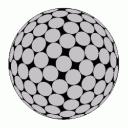Yahoo Answers is shutting down on May 4th, 2021 (Eastern Time) and beginning April 20th, 2021 (Eastern Time) the Yahoo Answers website will be in read-only mode. There will be no changes to other Yahoo properties or services, or your Yahoo account. You can find more information about the Yahoo Answers shutdown and how to download your data on this help page.
Trending News
Non-congruent Polyhedrons with same Volume and Surface Area?
This is inspired by Manjyomesando1's very interesting question:
http://answers.yahoo.com/question/index;_ylt=Aqs8_...
As shown there, infinitely many pairs of non-congruent polyhedrons with the same volume (V) and surface area(S) exist, I repeat here some of them for convenience:
Octahedrons:
http://farm4.static.flickr.com/3004/2802617542_794...
Hexahedrons:
http://farm4.static.flickr.com/3582/3294907454_839...
/both #2 and #3 can be obtained truncating Kepler's Stella Octangula:
http://en.wikipedia.org/wiki/Stella_octangula
removing 6 out of its 8 thorns/
Dragan K's cuboids: 1 x 1 x (p(p+1)/2) and p x p x ((p+1)/(2p)) /p≠1/
Now the question: what is the combined minimal number of faces of such pair?
I began to play with a right triangular prism with right isosceles bases and lateral faces in planes x=0, y=0, x+y=1 as shown here:
http://farm4.static.flickr.com/3570/3382194753_049...
Taking red triangles instead of black ones as bases, we obtain a pair of pentahedrons (#1 and #2) with the desired property - we can even join the rightmost vertexes in #2 to obtain a pyramid for the following result:
Prism: vertexes: (1, 0, 0), (1, 0, -2), (0, 1, 0), (0, 1, 2), (0, 0, ±1);
faces x = 0, y = 0, x + y = 1, x - y + z - 1 = 0, x - y + z + 1 = 0;
Pyramid: vertexes: (1, 0, 0), (0, 1, ±2), (0, 0, ±1);
faces x = 0, y = 0, x + y = 1, x - y + z - 1 = 0, x - y - z - 1 = 0
V = 1, S = 4 + 2√2 + √3 for both of them.
Finally, is 10 faces the combined minimum?
JB's example in EDIT 4 is a masterpiece!
Congratulations!!!
For me personally that was an astonishing result, but the minimum is 8 indeed - one of the most valuable answers on a mathematical question I have received so far.
Now it remains (may turn out difficult) to determine what is the combined minimal number of faces of a pair of topologically different polyhedrons with the desired property. Since all tetrahedrons are topologically equivalent and there is such pair of pentahedrons (my example above), does a tetrahedron-pentahedron pair exist, i.e. is that minimum 9?
2 Answers
- JBLv 71 decade agoFavorite Answer
I'm betting the minimal answer is 8. Now, back to work, to see if I have to eat my words.
--- ----
EDIT: OK, barring arithmetic errors here is an example of two non-congruent tetrahedra with the same volume and same surface area. Let the vertices be (2a,0,0), (0,2a,0), (0,0,3b), and (0,0,0). Then (if I calculate correctly),
V = 2a^2 b
SA = 6ab + a√(4a^2 + 18b^2)
First let a=11 and b=12, and second let a = 21.97444168338800490094 and b = 3.006982615620947182871 . In both cases
V = 2904
SA = 1402.078683449930087786
The exact value for SA is 792+11√3076. Although I have given the results as floating point approximations, one can make a continuity argument that shows there is a real number, a, near 22 for which the solution is exact. In fact, I believe a is the root of a polynomial of degree 10 from which it follows that b is then the root of a certain polynomial also.
I am sure there are easier examples. This is just the first thing I came up with.
---- -----
EDIT 2: Slightly simpler, in the same family of tetrahedra, let b = 36/a^2. Then the volume is 72 and the surface area is (2/a)(108+ √(a^6+5832)). This surface area is equal to 126 exactly for both a = 3 and for a = 3x, where x is the root of x^5 + x^4 + x^3 + x^2 - 48x + 8 nearest to 2. This second value of a is approximately 6.7552093628.
---- -----
EDIT 3: Duke has kindly pointed out that I have made errors under EDIT 2. However, the idea was right. Please ignore EDIT 2. I will fix it here:
Slightly simpler, in the same family of tetrahedra, let b = 36/a^2. Then the volume is 72, independent of a, and the surface area is (2/a)(a^3 + 108 + √(a^6+5832)). This surface area is equal to 144 exactly for both a = 3 and for a equal to the root of the polynomial 2a^3 + 3a^2 - 63a + 27 which is nearest to 5, and whose approximate value is a ≈ 4.64992867166. This polynomial arises by equating (2/a)(a^3 + 108 + √(a^6+5832)) to 144 and solving for a, which involves squaring and removing the root a = 3.
--- ----
EDIT 4: Here is a much simpler example. The pyramid (tetrahedron) with an equilateral triangle of edge e for base, and isosceles triangles with equal edges s for sides, has (if I calculate correctly),
Volume = (e^2/12)√(3s^2 - e^2) and
Surface Area = (e/4)(e√3 + 3√(4s^2 - e^2))
Now consider two (non-congruent) such pyramids, the first with e=√2, s=√(146/3) and the second with e=4, s=√(73/12), and compute. You will find they both have Volume=2, and Surface Area = 9√3.
- Anonymous5 years ago
Total surface area of cylinder = 2*pi*r*(r+h), where r is radius and h is height. Since r = h Total surface area of cylinder = 4*pi*r^2 ---------------(1) Volume of cylinder = pi*r^2*h = pi*r^3 (since r = h) -------------- (2) Equate (1) and (2) 4*pi*r^2 = pi*r^3 So r = 4 units And since r = h, the height is also 4 units. So the cylinder has the raduis as well as height of 4 units.


